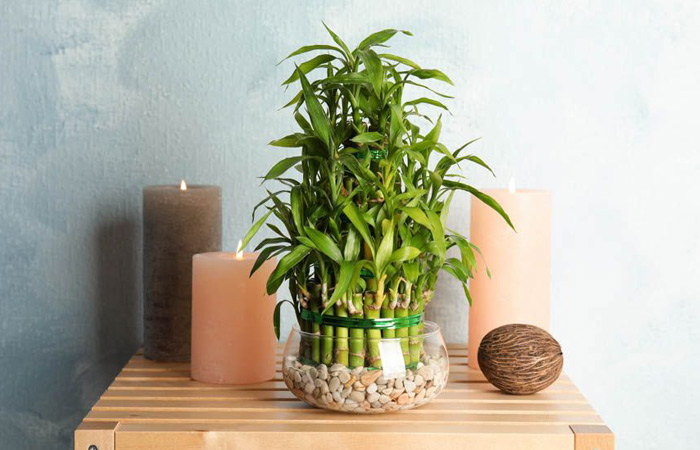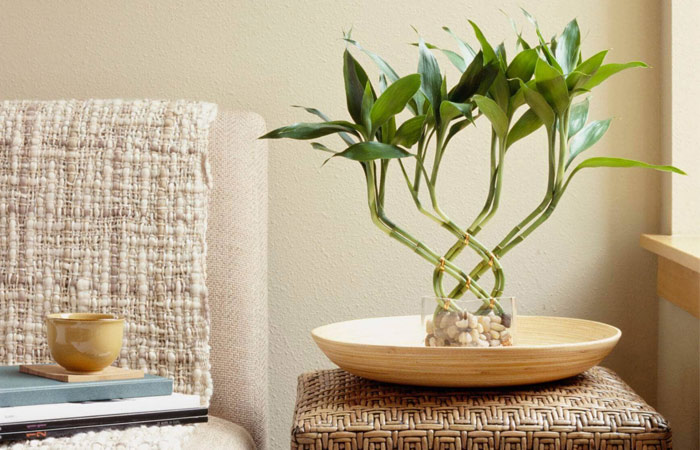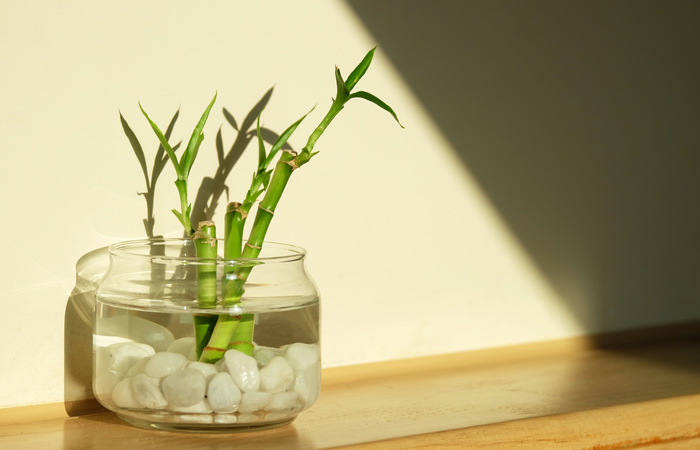Lucky Bamboo Care Guide (for Bamboo Plants Indoor)

There is just something fascinating about bamboo plants. They are as elegant as a houseplant can be while requiring minimum care. Additionally, some believe that it brings good luck to its owner.
However, what people have in mind when searching about bamboo plant care is not actually those large bamboo trees. Although they are perfectly fine to grow outdoors and even indoors, it is the lucky bamboo that people adore.
The catch is that the lucky bamboo plant is not actually bamboo, which is tall and big grass with woody stems. Also known as the Chinese water bamboo, the ribbon plant, and friendship bamboo, the lucky bamboo is in fact native to Africa.
And in today’s article, we are going to tell you all about this amazing plant, from lucky bamboo care to its common problems.
Lucky Bamboo Care; How to Grow Lucky Bamboo?
Scientifically called Dracaena Sanderiana, this plant is a perennial shrub from Asparagaceae. With proper care, the lucky bamboo plant can grow 1 to 3 feet tall and 1 to 2 feet wide indoors.
These plants are incredibly low-maintenance and durable. They grow moderately fast (around 19 inches in six months) and live for one to two years, which can extend if planted in soil. To have the healthiest and most vibrant, remember these requirements:
Light
What makes the Chinese water bamboo a great indoor plant is that it tolerates light shade and indirect sunlight. Provide it with bright sunlight that is filtered, as it grows larger in bright light (its leaves may scorch too).
Keep in mind that in bamboo plant care, little sunlight is better than too much light. Only when the beautiful green color of the leaves starts to fade, it is time to place your plant in a spot with more light.
Soil
Any acidic, well-drained, and rich potting soil will work for growing lucky bamboo. You should keep this soil moist (and not soaking to avoid a negative impact on the plant’s growth).
The soil is not the only medium to grow this plant, as it can also thrive in pebbles with an inch of standing water, or simply a vase filled with filtered or distilled water.
Potting
If your ribbon plant outgrew its original container, which is usually on top of pebbles or beads, follow these steps to transfer it to its new container:
- Gently dig the plant up the bamboo plant and wash the pebbles away.
- Place the bamboo plant in the new container and carefully bury its roots beneath the pebbles to ensure that they are covered well.
- Keep the water level high enough to cover the roots (at least an inch), but not so high that the stalks get wet.
In lucky bamboo plant care, it is also important to provide the proper drainage. If growing in soil, make sure its container has good drainage. When the top inch of the soil is dry, water the potting soil.
Water
Do not use tap water for lucky bamboo care, as the chlorine and other chemicals in tap water can burn its stalks. So only use bottled or distilled water or tap water that has been left out for at least a day to water your plant. If you are growing your bamboo in water, change the water weekly to avoid diseases and unpleasant odors.

Temperature and Humidity
The friendship bamboo grows best in warmer temperatures between 16 to 24°C (not cooler than 10°C) with average humidity.
The worst locations for bamboo plants indoors include draughty areas or places where the temperature fluctuates a lot such as anywhere near both hot and cold draft, in front of air conditioners, heating vents, or next to a drafty window.
Feeding
Including fertilizing in lucky bamboo care is not crucial. A small drop of liquid fertilizer each month is more than enough for this plant. If growing in water, only feed every other month or so with a very weak liquid fertilizer. You can use specialty fertilizers as well.
Pruning
Pruning is an important part of bamboo plant care. When pruning, use sterile snippers and cut the offshoots using sterile snippers and avoid cutting the main stalk. New offshoots will grow soon emerge, giving your lucky bamboo a bushier look, just like a bonsai. If that is not what you are looking for, simply dip the cut end in paraffin.
Shaping
Trimming is not how you shape a Chinese water bamboo. Instead, you need to rotate the stalks in front of a light source, naturally making the plant grow toward the light.
Professionals grow stalks on their sides to create eye-catching spiraling shapes. But this is quite challenging for bamboo plants indoors, demanding considerable patience and time. However, if you are eager to shape your plant like an expert, place it under a three-sided box. Pay close attention to its growth and rotate it slowly and regularly.

Lucky Bamboo Plant’s Common Problems
As you can see, questions like “how to take care of lucky bamboo” or “how to grow lucky bamboo” have simple answers.
Apart from tropical plants’ insect problems mealybugs, aphids, and mites, which can be treated by simply picking off bugs or other common methods such q mild liquid dish soap and water rinse, this easy-going plant may face other issues that mainly are due to the water quality:
Lucky Bamboo Turning Yellow
If you find yourself asking why is my lucky bamboo turning yellow, check the light or the feeding schedule. Yellow leaves indicate too much sun or too much fertilizer. In order to solve the matter, stop fertilizing and place the plant in a shadier location.
Brown Leaves and Tips
Brown leaves are a sign of dry air or polluted water. Raise the humidity level by misting the plant regularly. Also, double-check the quality of the water that you are using for growing the plant.
If you notice leaf tips turning brown, it is probably because of using chlorinated water or water with high levels of additives. This can kill your bamboo plant over time. So do not hesitate in removing affected leaves with a sterile, sharp scissor. Remove dead leaves from the water to prevent bacteria too.
Bamboo Plant Black Roots
Healthy bamboo roots are red or orange. Developing black roots has multiple reasons. The best thing that you can do in this situation is to remove the black roots immediately with clean and transfer the stalks to a new container with fresh water.
Mushy and Black Stalks
If the stalks look rotten, it is too late to save them. mushy and black stalks tell us that the roots are likely dead or dying. This problem has also different reasons including poor water quality, fungi, or bacteria.
Rotten stalks are a treat to other stalks, so cut them away immediately. Then change the water for the surviving stalks and replace the pebbles and stones in the container.
Algae in the Container
If you have potted your ribbon plant in a clear vase, you may notice algae growing in the water. Clear containers do not prevent light, resulting in algae growth. This problem easily goes away by washing the container with mild liquid dish detergent and water and starting again. If the algae were persistent, it may be a good idea to switch to an opaque container.

How To Propagate Lucky Bamboo
To propagate the ribbon plant, follow these:
- find a healthy parent stalk that has more than two bamboo segments and an offshoot.
- Cut the offshoot from where it connects to the parent stalk.
- Remove the offshoot’s bottom layer of leaves to have a new independent stalk.
- Place this stalk in a small container of water, grow it like a mature plant, and repot when needed.
- In this post:
- Lucky Bamboo Care; How to Grow Lucky Bamboo?
- Lucky Bamboo Plant’s Common Problems
- How To Propagate Lucky Bamboo



